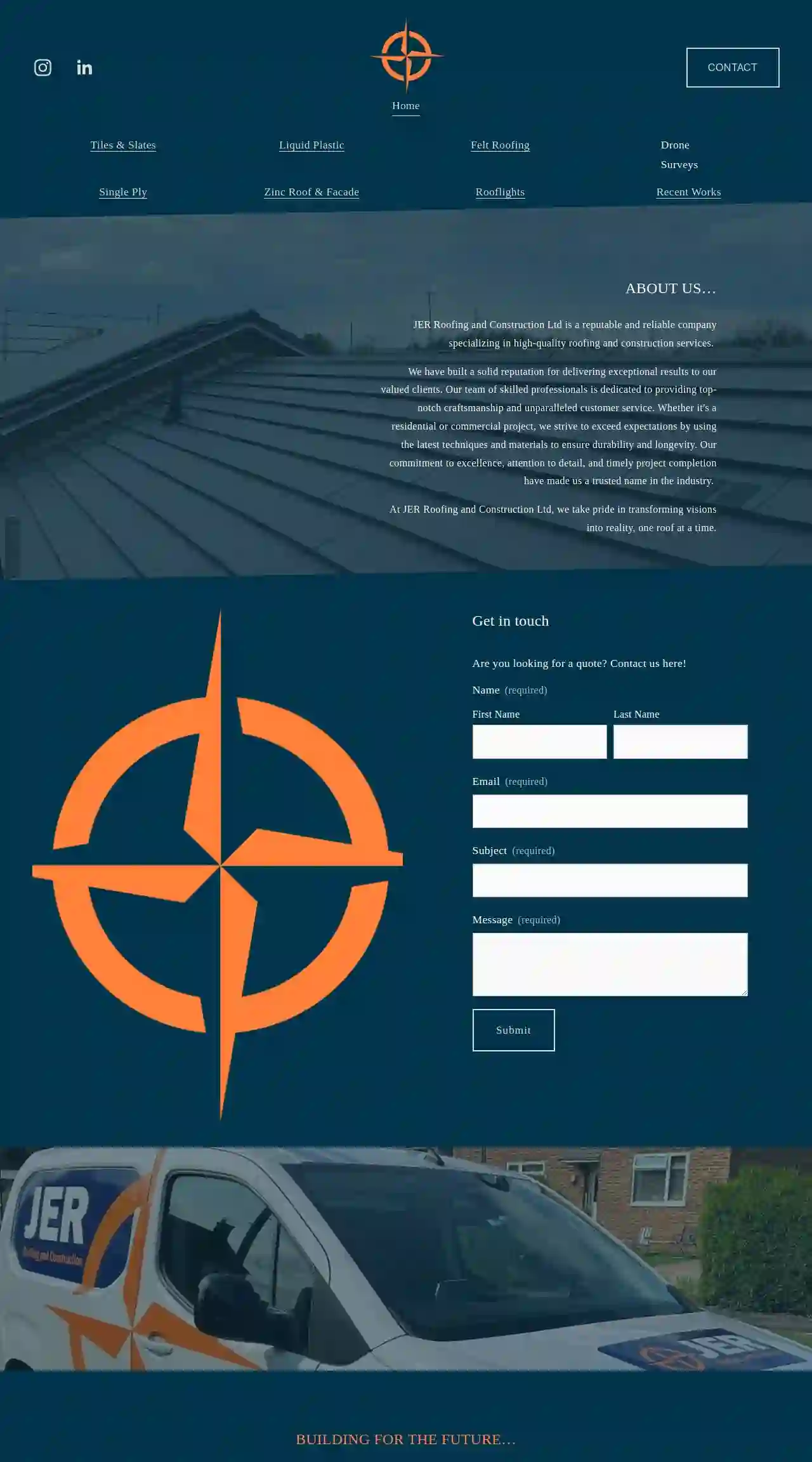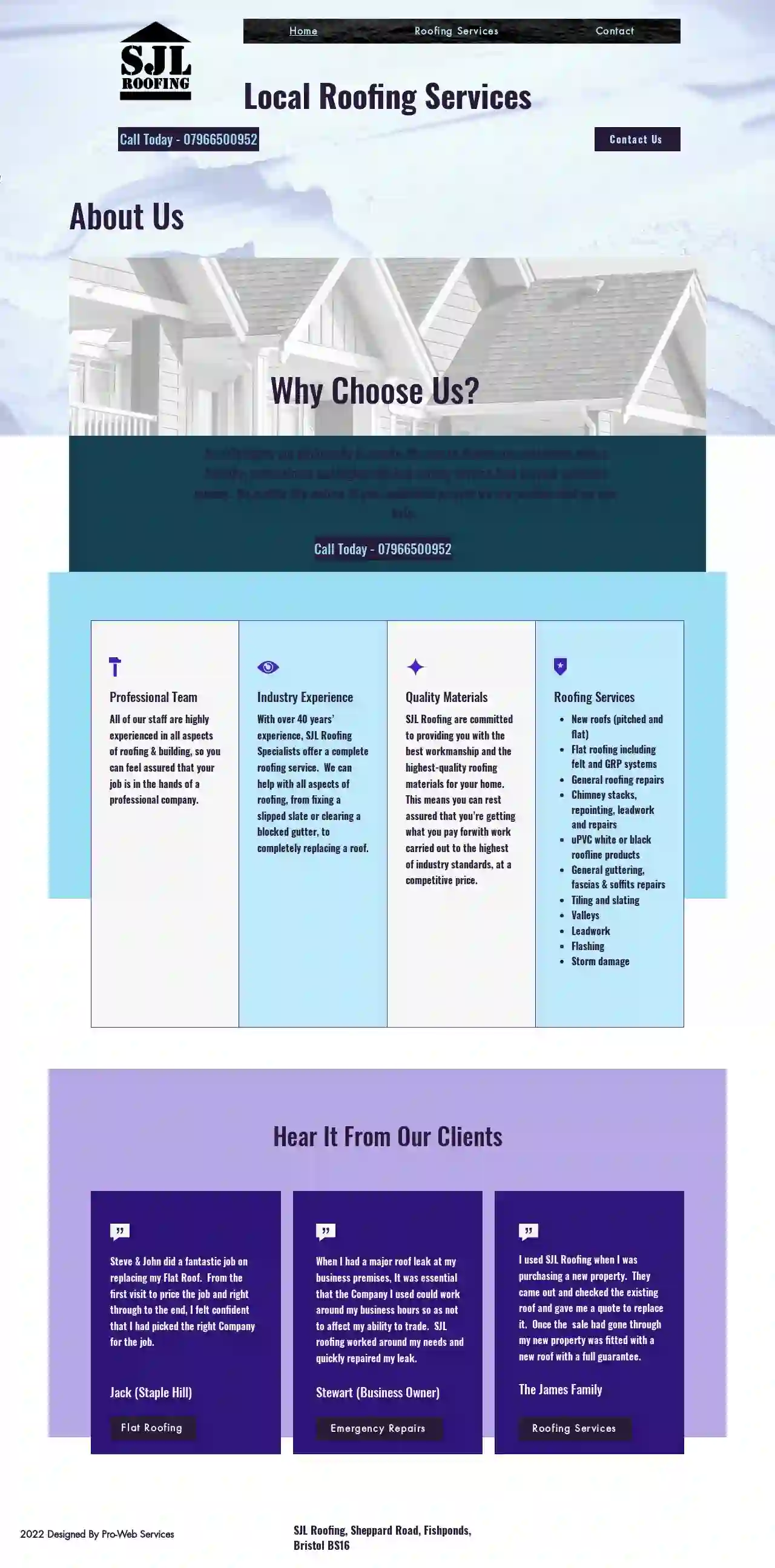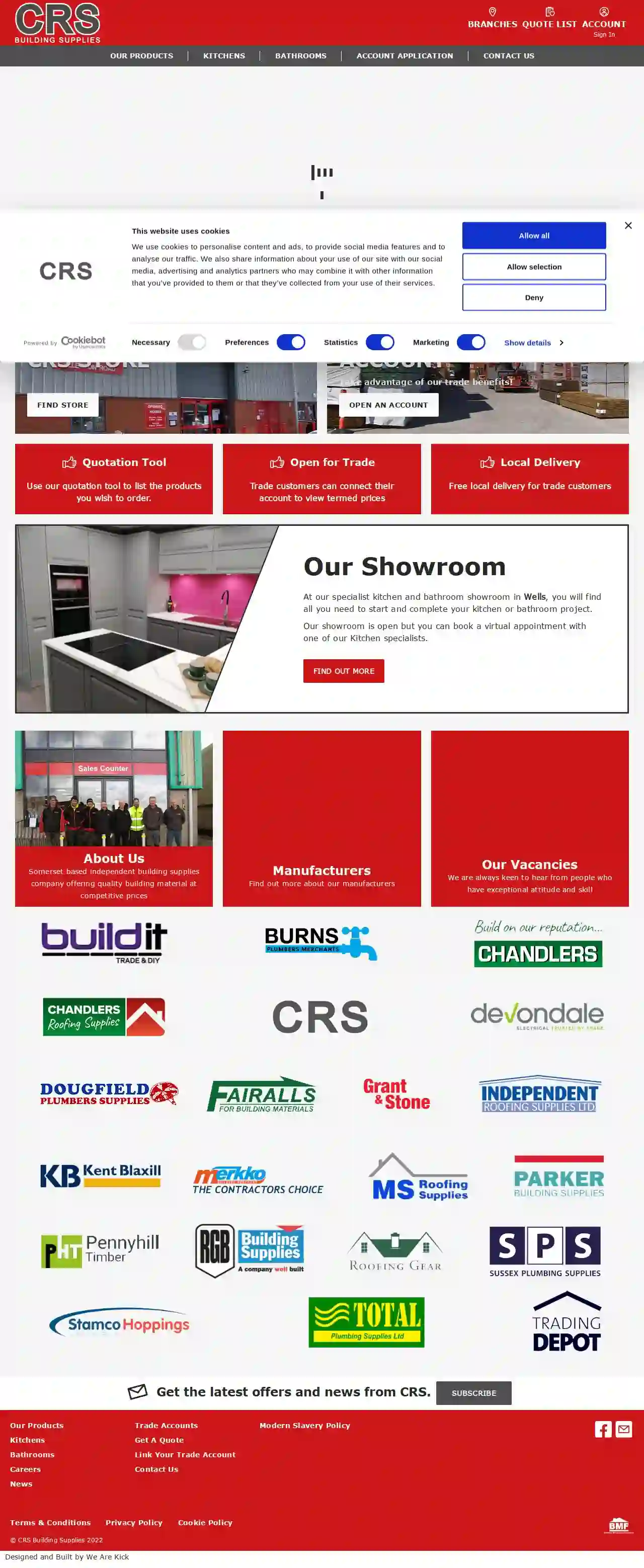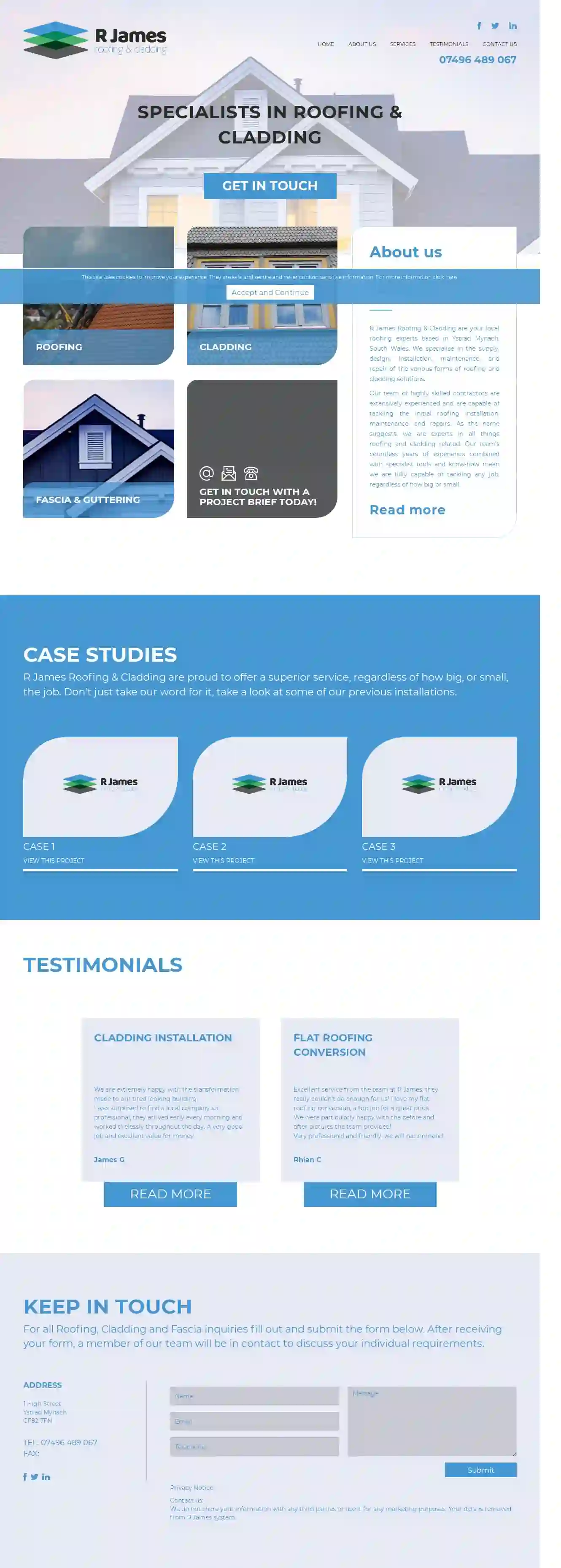Roofing Companies Marshfield
Find the best Roofing Service in Marshfield
Get multiple Roofing Company quotes for your project today! Compare profiles, reviews, accreditations, portfolio, etc... and choose the best offer.

AJH Roofing Ltd
4.637 reviewsGBAJH Roofing Ltd is a highly reputable roofing company based in Bristol, established since 1982. We pride ourselves on offering a wide range of roofing services at competitive prices, ensuring your home receives the best possible care. Our City & Guilds qualified team boasts years of experience in all aspects of roofing, handling projects big and small with equal expertise. We are committed to providing a professional, honest, and reliable service every time, guaranteeing all our work. Our services extend to roof tiling, flat roofing, fascias, soffits, guttering, roof repairs, and much more. For your convenience, we are available six days a week and offer free quotes.
- Services
- Why Us?
- Gallery
Get Quote
D D E Roofing & Property Maintenance
4.48 reviewsGBAt South Wales Roofing Network, our members are dedicated to providing a comprehensive range of roofing services across South Wales. Whether you need roof repairs, flat roofing, pitched roofing, fascias and soffits, or any other roofing-related service, our experienced and qualified team can handle it all. We understand the importance of a well-built roof for your home or business, and we strive to deliver high-quality workmanship and exceptional customer service. From small repairs to large-scale projects, we have the expertise and resources to meet your needs. Contact us today to receive a free quotation and let us help you protect your property with a reliable and durable roof.
- Services
- Why Us?
- Gallery
Get Quote
JER Roofing and Construction Ltd
Victory House, 400 Pavilion Drive, Northampton, NN47PA, GBJER Roofing and Construction Ltd is a reputable and reliable company specializing in high-quality roofing and construction services. We have built a solid reputation for delivering exceptional results to our valued clients. Our team of skilled professionals is dedicated to providing top-notch craftsmanship and unparalleled customer service. Whether it's a residential or commercial project, we strive to exceed expectations by using the latest techniques and materials to ensure durability and longevity. Our commitment to excellence, attention to detail, and timely project completion have made us a trusted name in the industry. At JER Roofing and Construction Ltd, we take pride in transforming visions into reality, one roof at a time.
- Services
- Why Us?
- Gallery
Get Quote
Gareth Swan Roofing
4.840 reviewsGBGareth Swan & Son Roofing has been established for over 30 years and is now entering its 3rd generation of roofers. We cover all of Wales and parts of England. We pride ourselves on our roofing work which is all guaranteed and we take pride in the work we undertake. We pride ourselves on our track record of finishing a job the first time around, giving clients peace of mind. We also undertake work for big site clients. Commercial or Domestic, no job too big or too small. All our roofers carry CsCs cards and are public liability covered. If you need any expert advice on any of the services we offer please don’t hesitate to get in contact.
- Services
- Why Us?
- Accreditations
- Our Team
- Testimonials
- Gallery
Get Quote
Jones K Roofing
51 reviewsGBAt South Wales Roofing Network, our members are dedicated to providing a comprehensive range of roofing services across South Wales. Whether you need roof repairs, flat roofing, pitched roofing, fascias and soffits, or any other roofing-related service, our experienced and qualified team can handle it all. We understand the importance of a well-built roof for your home or business, and we strive to deliver exceptional workmanship and customer satisfaction. Our members are committed to using high-quality materials and the latest roofing techniques to ensure long-lasting and reliable results. We cover a wide range of areas throughout South Wales, so no matter where you are located, we can provide you with the roofing solutions you need. Contact us today to receive a free quotation and let us take care of your roofing needs.
- Services
- Why Us?
- Accreditations
- Gallery
Get Quote
Roma Roofing Supplies Ltd
4.321 reviewsBrooklyn Yard, Trenant, Hirwaun, CF44 9HR, GBRoma Roofing Supplies is a leading roofing supplier in Wales, offering a wide range of high-quality products to both trade and public customers. With a team of experts dedicated to providing exceptional customer service, Roma Roofing Supplies is committed to helping you find the perfect roofing solutions for your needs. They stock a vast selection of roofing materials, including box profile sheets, corrugated sheets, roof tiles, guttering and rainwater systems, fibre glass roofing, UPVC products, and timber. Their online shop offers thousands of products, and they pride themselves on competitive pricing and fast delivery. Roma Roofing Supplies is known for its commitment to customer satisfaction, as evidenced by numerous positive testimonials from satisfied customers who praise their expertise, competitive prices, and reliable service.
- Services
- Why Us?
- Testimonials
- Gallery
Get Quote
SJL Roofing Bristol
52 reviewsSheppard Road, Fishponds, BS16, GBAs a Company our philosophy is simple. We aim to deliver our customers with a friendly, professional and highly efficient roofing service that is great value for money. No matter the nature of your individual project we are positive that we can help. All of our staff are highly experienced in all aspects of roofing & building, so you can feel assured that your job is in the hands of a professional company. With over 40 years’ experience, SJL Roofing Specialists offer a complete roofing service. We can help with all aspects of roofing, from fixing a slipped slate or clearing a blocked gutter, to completely replacing a roof. SJL Roofing are committed to providing you with the best workmanship and the highest-quality roofing materials for your home. This means you can rest assured that you’re getting what you pay forwith work carried out to the highest of industry standards, at a competitive price.
- Services
- Why Us?
- Our Team
- Testimonials
- Gallery
Get Quote
CRS Building Supplies Bridgwater
4.613 reviewsMart Road, Unit 1, Vennland Centre, Minehead, TA24 5BJ, GBCRS Building Supplies is a Somerset-based independent building supplies company dedicated to providing quality building materials at competitive prices. With a wide range of products, including kitchens and bathrooms, they cater to both trade and retail customers. Their team of experts is committed to offering exceptional service and support. CRS Building Supplies also boasts a specialist kitchen and bathroom showroom in Wells, where customers can explore their options and receive personalized advice. They are always looking for talented individuals to join their team and encourage applications from those with a strong work ethic and skills.
- Services
- Why Us?
- Gallery
Get Quote
Ross James Roofing & Cladding
1 High Street, Ystrad Mynach, CF82 7FN, GBR James Roofing & Cladding are your local roofing experts based in Ystrad Mynach, South Wales. We specialise in the supply, design, installation, maintenance, and repair of the various forms of roofing and cladding solutions. Our team of highly skilled contractors are extensively experienced and are capable of tackling the initial roofing installation, maintenance, and repairs. As the name suggests, we are experts in all things roofing and cladding related. Our team's countless years of experience combined with specialist tools and know-how mean we are fully capable of tackling any job, regardless of how big or small.
- Services
- Why Us?
- Testimonials
- Gallery
Get Quote
A silcox roofing services
52 reviewsGBSouth Wales Roofing Network is a network of roofing professionals serving the South Wales region. We offer a wide range of roofing services for both domestic and commercial properties, including roof repairs, flat roofing, pitched roofing, fascias and soffits, and more. Our members are experienced and qualified roofers who are committed to providing high-quality workmanship and customer service. We understand that your roof is a vital part of your home or business, and we take pride in ensuring that it is properly protected. Whether you need a small repair or a complete roof replacement, our team can help. Contact us today for a free quote.
- Services
- Why Us?
- Accreditations
- Our Team
- Testimonials
- Gallery
Get Quote
Over 12,314+ Roofers on our directory
Our roofing experts operate in Marshfield and surroundings!
Roofyng.co.uk has curated and vetted Top Roofers in and around Marshfield. Find a top & reliable contractor today.
Frequently Asked Questions About Roofing Companies
- Hot Climates: Opt for light-colored or reflective roofing materials to reduce heat absorption. Consider tile roofs for their thermal mass and heat resistance.
- Cold Climates: Ensure your roof has adequate insulation and ventilation to prevent ice dams and moisture buildup. Metal roofs can shed snow effectively.
- High-Wind Areas: Choose roofing systems with high wind ratings and properly installed hurricane straps or clips to enhance wind resistance.
- Areas with Heavy Rainfall: Ensure your roof has proper drainage and a waterproof membrane to prevent leaks.
- Ventilation: Soffit vents provide intake ventilation, allowing fresh air to enter the attic and regulate temperature and moisture.
- Aesthetics: It creates a finished look to the roof's underside.
- Pest Control: A properly sealed soffit prevents pests like birds and squirrels from nesting in the attic.
How do I choose the right type of roof for my climate?
What is fascia, and why is it important?
What is the difference between a roof overlay and a roof tear-off?
Roof Overlay: Installing a new layer of roofing material over the existing roof. It's less expensive and faster, but not always ideal.
Roof Tear-Off: Completely removing the existing roofing before installing a new one. More labor-intensive but allows for inspection and repairs to the roof deck.
A tear-off is typically preferred, but a roofing contractor can advise on the best approach for your situation.
What is a soffit, and why is it important for my roof?
How do I choose the right type of roof for my climate?
- Hot Climates: Opt for light-colored or reflective roofing materials to reduce heat absorption. Consider tile roofs for their thermal mass and heat resistance.
- Cold Climates: Ensure your roof has adequate insulation and ventilation to prevent ice dams and moisture buildup. Metal roofs can shed snow effectively.
- High-Wind Areas: Choose roofing systems with high wind ratings and properly installed hurricane straps or clips to enhance wind resistance.
- Areas with Heavy Rainfall: Ensure your roof has proper drainage and a waterproof membrane to prevent leaks.
What is fascia, and why is it important?
What is the difference between a roof overlay and a roof tear-off?
Roof Overlay: Installing a new layer of roofing material over the existing roof. It's less expensive and faster, but not always ideal.
Roof Tear-Off: Completely removing the existing roofing before installing a new one. More labor-intensive but allows for inspection and repairs to the roof deck.
A tear-off is typically preferred, but a roofing contractor can advise on the best approach for your situation.
What is a soffit, and why is it important for my roof?
- Ventilation: Soffit vents provide intake ventilation, allowing fresh air to enter the attic and regulate temperature and moisture.
- Aesthetics: It creates a finished look to the roof's underside.
- Pest Control: A properly sealed soffit prevents pests like birds and squirrels from nesting in the attic.